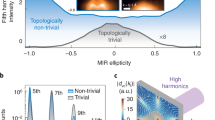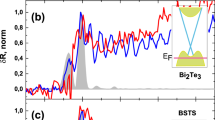Abstract
Three-dimensional topological insulators are a phase of matter that hosts unique spin-polarized gapless surface states that are protected by time-reversal symmetry. They exhibit unconventional charge and spin transport properties1,2. Intense laser fields can drive ballistic charge dynamics in Dirac bands3,4 or they can coherently steer spin5 and valley pseudospin6. Similarly, high-harmonic generation (HHG) in solids provides insights into the dynamics of the electrons in topological insulators7,8,9,10,11,12,13. Despite several theoretical attempts to identify a topological signature in the high-harmonic spectrum14,15,16, a unique fingerprint has yet to be found experimentally. Here, we observe HHG that arises from topological surface states in the intrinsic topological insulator BiSbTeSe2. The components of the even-order harmonics that are polarized along the pump polarization stem from the spin current in helical surface states, whereas the perpendicular components originate from the out-of-plane spin polarization related to the hexagonal wrapping effect17. The dependence of HHG on surface doping in ambient air also suggests the presence of a Rashba-split two-dimensional electron gas, whose strength can be enhanced by an increase in the intensity of the mid-infrared pump.
This is a preview of subscription content, access via your institution
Access options
Access Nature and 54 other Nature Portfolio journals
Get Nature+, our best-value online-access subscription
$29.99 / 30 days
cancel any time
Subscribe to this journal
Receive 12 print issues and online access
$209.00 per year
only $17.42 per issue
Buy this article
- Purchase on Springer Link
- Instant access to full article PDF
Prices may be subject to local taxes which are calculated during checkout




Similar content being viewed by others
Data availability
Source data are available for this paper. All other data that support the plots within this paper and other findings of this study are available from the corresponding author upon reasonable request.
Code availability
The analysis codes that support the findings of the study are available from the corresponding authors upon reasonable request.
References
Hasan, M. Z. & Kane, C. L. Colloquium: topological insulators. Rev. Mod. Phys. 82, 3045–3067 (2010).
Qi, X. & Zhang, S. Topological insulators and superconductors. Rev. Mod. Phys. 83, 1057–1110 (2011).
Higuchi, T., Heide, C., Ullmann, K., Weber, H. B. & Hommelhoff, P. Light-field-driven currents in graphene. Nature 550, 224–228 (2017).
Reimann, J. et al. Subcycle observation of lightwave-driven Dirac currents in a topological surface band. Nature 562, 396–400 (2018).
Schlauderer, S. et al. Temporal and spectral fingerprints of ultrafast all-coherent spin switching. Nature 569, 383–387 (2019).
Langer, F. et al. Lightwave valleytronics in a monolayer of tungsten diselenide. Nature 557, 76–80 (2018).
Ghimire, S. et al. Observation of high-order harmonic generation in a bulk crystal. Nat. Phys. 7, 138–141 (2011).
Schubert, O. et al. Sub-cycle control of terahertz high-harmonic generation by dynamical Bloch oscillations. Nat. Photon. 8, 119–123 (2014).
Hohenleutner, M. et al. Real-time observation of interfering crystal electrons in high-harmonic generation. Nature 523, 572–575 (2015).
Liu, H. et al. High-harmonic generation from an atomically thin semiconductor. Nat. Phys. 13, 262–265 (2017).
Yoshikawa, N., Tamaya, T. & Tanaka, K. High-harmonic generation in graphene enhanced by elliptically polarized light excitation. Science 356, 736–738 (2017).
Hafez, H. A. et al. Extremely efficient terahertz high-harmonic generation in graphene by hot Dirac fermions. Nature 561, 507–511 (2018).
Luu, T. T. & Wörner, H. J. Measurement of the Berry curvature of solids using high-harmonic spectroscopy. Nat. Commun. 9, 916 (2018).
Bauer, D. & Hansen, K. K. High-harmonic generation in solids with and without topological edge states. Phys. Rev. Lett. 120, 177401 (2018).
Silva, R. E. F., Jiménez-Galán, A., Amorim, B., Smirnova, O. & Ivanov, M. Topological strong-field physics on sub-laser-cycle timescale. Nat. Photon. 13, 849–854 (2019).
Chacón, A. et al. Circular dichroism in high-order harmonic generation: heralding topological phases and transitions in Chern insulators. Preprint at https://arxiv.org/abs/1807.01616 (2020).
Fu, L. Hexagonal warping effects in the surface states of the topological insulator Bi2Te3. Phys. Rev. Lett. 103, 266801 (2009).
Soumyanarayanan, A., Reyren, N., Fert, A. & Panagopoulos, C. Emergent phenomena induced by spin–orbit coupling at surfaces and interfaces. Nature 539, 509–517 (2016).
Mellnik, A. R. et al. Spin-transfer torque generated by a topological insulator. Nature 511, 449–451 (2014).
Wang, Y. et al. Topological surface states originated spin–orbit torques in Bi2Se3. Phys. Rev. Lett. 114, 257202 (2015).
Xu, Y. et al. Observation of topological surface state quantum Hall effect in an intrinsic three-dimensional topological insulator. Nat. Phys. 10, 956–963 (2014).
Kaneshima, K. et al. Polarization-resolved study of high harmonics from bulk semiconductors. Phys. Rev. Lett. 120, 243903 (2018).
German, R. et al. Phonon mode calculations and Raman spectroscopy of the bulk-insulating topological insulator BiSbTeSe2. Phys. Rev. Mater. 3, 054204 (2019).
Brahlek, M. et al. Topological-metal to band-insulator transition in (Bi1−xInx)2Se3 thin films. Phys. Rev. Lett. 109, 186403 (2012).
Bianchi, M. et al. Coexistence of the topological state and a two-dimensional electron gas on the surface of Bi2Se3. Nat. Commun. 1, 128 (2010).
Benia, H. M., Lin, C., Kern, K. & Ast, C. R. Reactive chemical doping of the Bi2Se3 topological insulator. Phys. Rev. Lett. 107, 177602 (2011).
Hsieh, D. et al. Nonlinear optical probe of tunable surface electrons on a topological insulator. Phys. Rev. Lett. 106, 057401 (2011).
Sim, S. et al. Ultra-high modulation depth exceeding 2,400% in optically controlled topological surface plasmons. Nat. Commun. 6, 8814 (2015).
Park, S. H., Hamh, S. Y., Park, J., Kim, J. S. & Lee, J. S. Possible flat band bending of the Bi1.5Sb0.5Te1.7Se1.3 crystal cleaved in an ambient air probed by terahertz emission spectroscopy. Sci. Rep. 6, 36343 (2016).
Neupane, M. et al. Gigantic surface lifetime of an intrinsic topological insulator. Phys. Rev. Lett. 115, 116801 (2015).
Manchon, A., Koo, H. C., Nitta, J., Frolov, S. M. & Duine, R. A. New perspectives for Rashba spin–orbit coupling. Nat. Mater. 14, 871–882 (2015).
Ishizaka, K. et al. Giant Rashba-type spin splitting in bulk BiTeI. Nat. Mater. 10, 521–526 (2011).
Culcer, D. et al. Semiclassical spin transport in spin–orbit-coupled bands. Phys. Rev. Lett. 93, 046602 (2004).
Iyer, V., Chen, Y. P. & Xu, X. Ultrafast surface state spin-carrier dynamics in the topological insulator Bi2Te2Se. Phys. Rev. Lett. 121, 026807 (2018).
Shen S. -Q. (ed.) in Topological Insulators: Dirac Equation in Condensed Matters 1st edn, Ch. 6 (Springer, 2012).
Liu, C. X. et al. Model Hamiltonian for topological insulators. Phys. Rev. B 82, 045122 (2010).
Acknowledgements
This project was supported by the National Natural Science Foundation of China (grant no. 11874373) and the Scientific Instrument Developing Project of the Chinese Academy of Sciences (grant no. YJKYYQ20180023).
Author information
Authors and Affiliations
Contributions
Y.B., F.S. and P.L. initiated the project. Y.B., P.L., S.W. and N.L. carried out the experiments. F.F. and F.S. produced the crystals and carried out the transport measurements. Y.B. and P.L. analysed the data. Y.B. performed the modelling. Y.B., F.F., F.S. and P.L. wrote the manuscript with with input from S.W., N.L., X.L., R.L. and Z.X.
Corresponding authors
Ethics declarations
Competing interests
The authors declare no competing interests.
Additional information
Peer review information Nature Physics thanks Tran Trung Luu and the other, anonymous, reviewer(s) for their contribution to the peer review of this work.
Publisher’s note Springer Nature remains neutral with regard to jurisdictional claims in published maps and institutional affiliations.
Extended data
Extended Data Fig. 1 Pump intensity dependence of high-harmonic yields from BSTS.
Intensities of harmonic orders H4-H7 as a function of the peak pump intensity. The gray solid lines are fitted to the power law, Ip. For H4 and H6 the power indexes are similar, p = 3.6 and 3.7, respectively, which confirms the non-perturbative behavior.
Extended Data Fig. 2 Polarizations of high-harmonics from BSTS.
a, b, Polarizations of the H4 and H5 harmonics for crystal angle φ = 0˚ (a) and φ = 30˚ (b), respectively. The red arrow indicates the polarization of the mid-IR pump pulse. Gray lines are the fitting result.
Extended Data Fig. 3 High-harmonic spectrum from (Bi0.8In0.2)2Se3.
The spectrum shows the H4-H6 harmonics extend from 1.25–2.5 eV, measured at crystal angle φ = 0° and pump intensity 9 GW/cm2.
Extended Data Fig. 4 Time evolution of high-harmonic intensity for BSTS angle φ = 0°.
Intensity of the H4 and H6 harmonics as a function of cleavage time at pump intensity 9 GW/cm2. The stage II and III also exist, similar as that illustrated in Fig. 3b. Especially, the slowly varying stage I is clearly shown in the local enlarged image. The black solid line represents the exponential fit of the measured data, which gives a phenomenological time constant of tc = 3 min for stage II, and tc = 56 min for stage III.
Extended Data Fig. 5 Energy dispersion and spin texture of the topological surface states in 2D Brillouin zone.
a, Schematic of the spin texture of the surface states near the Γ point, For the conduction band, the helicity is left handed, while for the valence band is right handed. b, Band structure of the surface states including hexagonal warping effect. c, The 2D surface Brillouin zone and its orientation in laboratory coordinate, in which kx, ky are along the \({\bar{\mathrm \Gamma }} - {\bar{\mathrm K}}\) and \({\bar{\mathrm \Gamma }} - {\bar{\mathrm M}}\) directions, respectively, kX, kY are along the horizontal and vertical direction in laboratory frame, respectively. The red arrow illustrates the pump pulse in s-polarization. The angle between \({\bar{\mathrm \Gamma }} - {\bar{\mathrm K}}\) direction and driven field is defined as θ = π/2 − φ.
Extended Data Fig. 6 The Berry curvature of the topological surface state.
The Berry curvature show clear threefold rotational symmetry. The values of the colorbar are in atomic unit.
Extended Data Fig. 7 Photo-induced band bending effect.
Under laser light illumination, photo-induced carriers are generated near the surface. Due to the band bending (gray dashed line) already existed, the electrons (e, blue solid circles) are accumulated near the surface attracted by the electrostatic potential, while the holes (h, blue open circles) are drift into the bulk, thus result in an intensified band bending (gray solid line). The red and green curves on the right-hand side show the band structure of the topological surface states (TSS) and Rashba-split two-dimensional electron gas (2DEG) states, the black arrows denote the spin polarization. EF: Fermi surface, BVB: bulk valence band, BCB: bulk conduction band.
Supplementary information
Supplementary Information
Supplementary Figures S1–S8, Supplementary Discussion (Sections I–III).
Source data
Source Data Fig. 1
Source data for Fig. 1.
Source Data Fig. 2
Source data for Fig. 2c–f.
Source Data Fig. 3
Source data for Fig. 3b–f.
Source Data Fig. 4
Source data for Fig. 4a,b.
Rights and permissions
About this article
Cite this article
Bai, Y., Fei, F., Wang, S. et al. High-harmonic generation from topological surface states. Nat. Phys. 17, 311–315 (2021). https://doi.org/10.1038/s41567-020-01052-8
Received:
Accepted:
Published:
Issue Date:
DOI: https://doi.org/10.1038/s41567-020-01052-8
This article is cited by
-
Observation of interband Berry phase in laser-driven crystals
Nature (2024)
-
Light control with Weyl semimetals
eLight (2023)
-
Attosecond magnetization dynamics in non-magnetic materials driven by intense femtosecond lasers
npj Computational Materials (2023)
-
Giant room-temperature nonlinearities in a monolayer Janus topological semiconductor
Nature Communications (2023)
-
Lightwave electronics in condensed matter
Nature Reviews Materials (2023)



